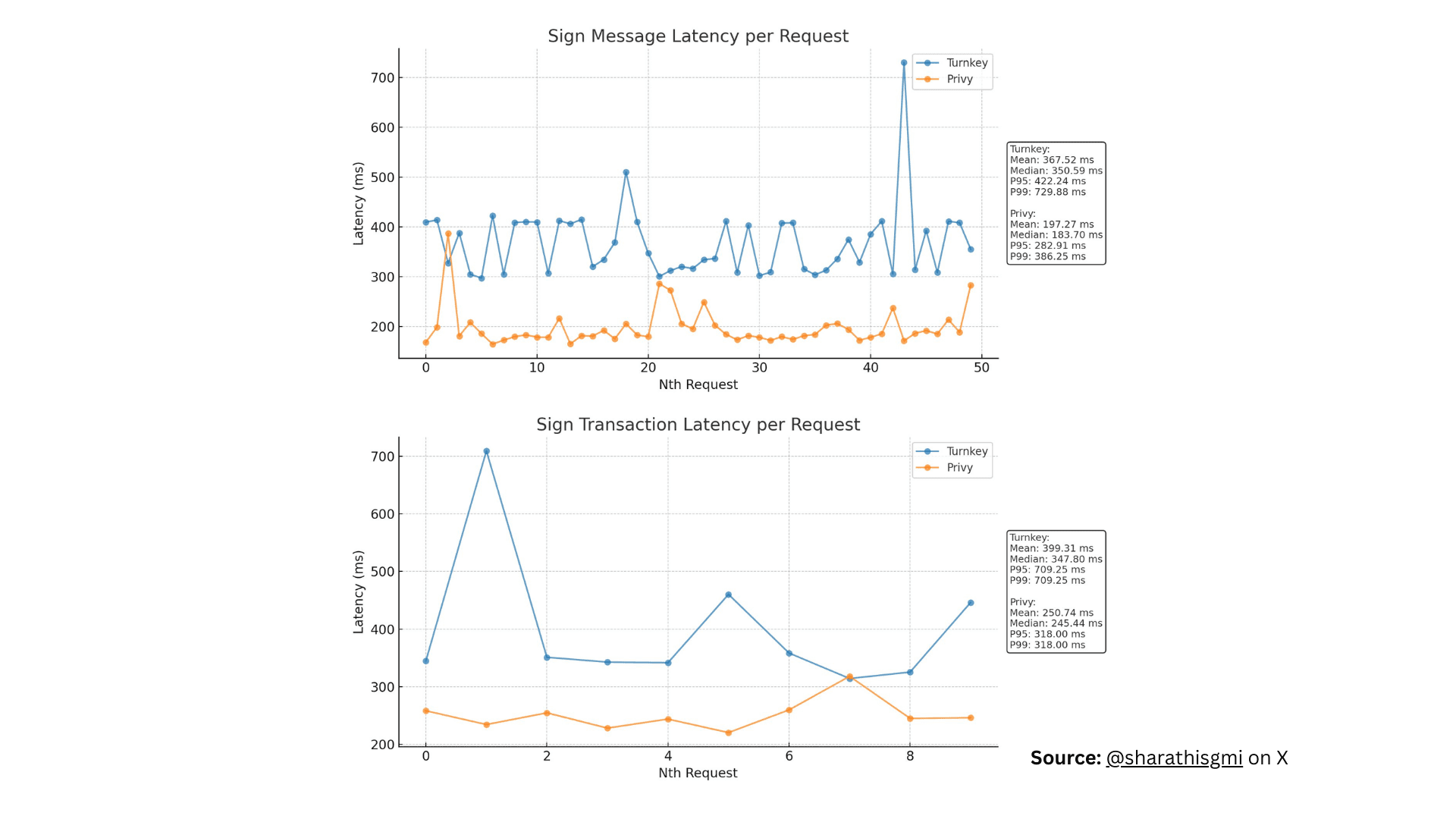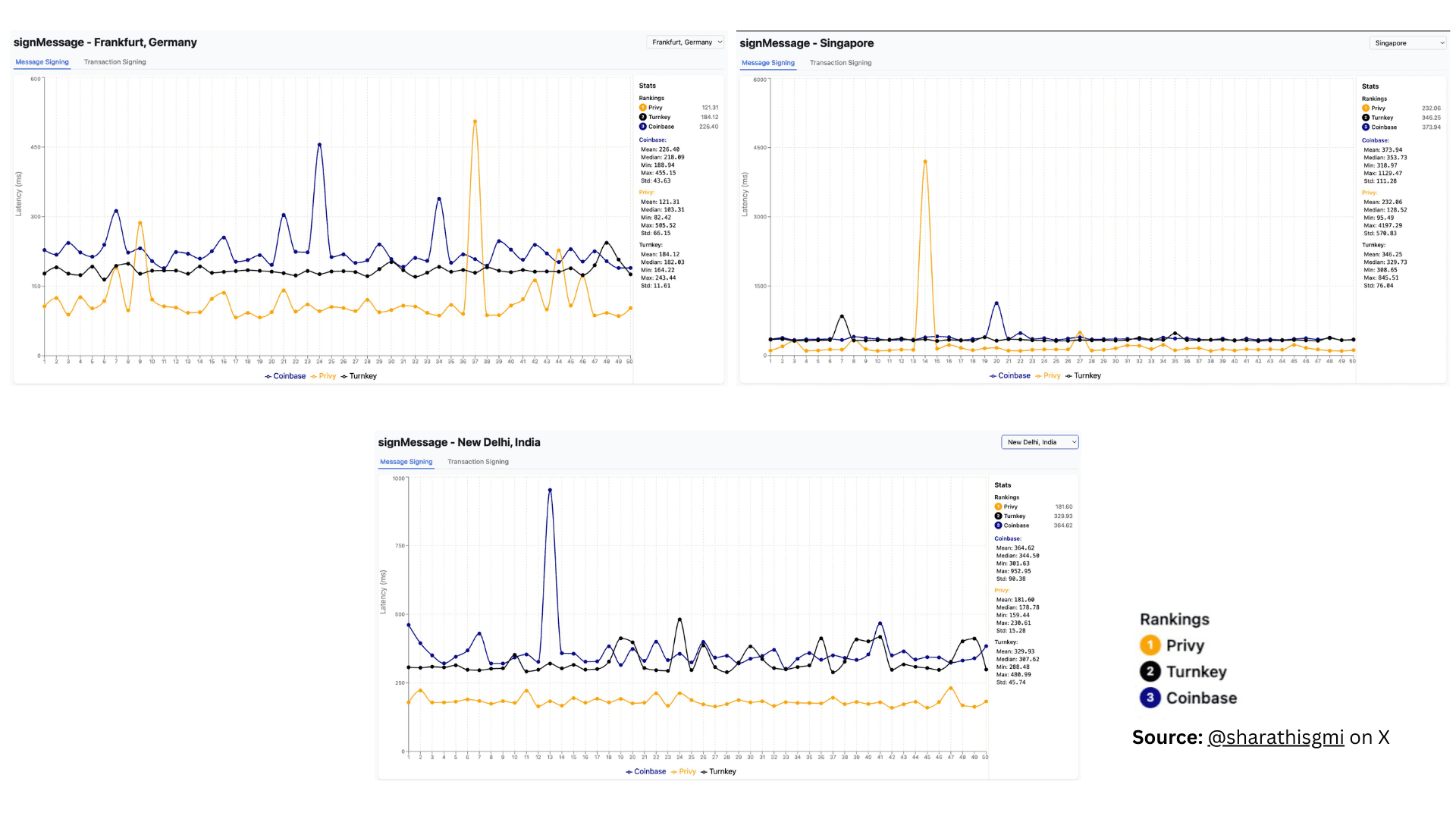Lowering Latency with Multi-Region Wallet Infrastructure
How Privy is building a faster path to transaction signing, no matter where your users are.
John Whelchel
|Aug 20, 2025

At Privy, security is paramount, but so is performance.
Every millisecond counts when a user is signing a transaction. This holds true whether they’re completing an in-game purchase, collecting an NFT, executing a trade, or making a stablecoin payment. Wallets should work just like any other modern software. That means lowering latency at the most important time: when users agree to an action and expect it to happen.
Today, Privy’s multi-region wallet infrastructure is live for all customers.
This change makes sure that the most important steps in signing transactions — authorizing the request, securely processing the transaction, and returning a signature — happen closer to the user, no matter where they are in the world. The result: big improvements in performance, with signature latency dropping by ~50-75% for our global users.
In recent third-party latency testing across a range of providers and three regions (Frankfurt, New Delhi, and Singapore), Privy consistently outperformed Turnkey and CDP’s embedded wallet offering, reinforcing the impact of our investment in infrastructure built for scale.


How we did it
This was a foundational change to our backend infrastructure, requiring teams to work closely together. The goal was clear: design and implement a solution that would perform well all throughout the world without excessive complexity or compromising consistency for our customer’s data.
Shifting from single-region to multi-region comes with a host of challenges. Key issues we had to tackle included data replication for reads, multi-region writing, distributed compute, and geo-routing. To do this securely, reliably, and swiftly across multiple datacenters, we had to rethink how requests go through our stack.
Here’s how we approached it:
Design and implementation We assessed many different global DB providers, from multi-primary to regional replicas, before settling on a combination that gave us the ideal mix of speed, ease of use, and security. This new structure now powers the signature path that processes requests in each region with the least amount of latency.
Scoping and planning Before we started working on the project, we made sure it was tightly scoped so that it could be done as planned with as little disturbance to the developers as possible. This offered us a clear plan for the rollout and let us see every element of change with confidence.
Analytics and testing We invested heavily in benchmarking, building an internal testing suite to compare Privy’s performance against other leading providers. That work didn’t just validate our approach. It also gave us the tooling to continuously track performance and catch regressions over time.
The end result is a multi-region signature system that speeds up everything without requiring any changes from developers who are currently using Privy. Signing requests are now automatically sent to the closest accessible area, which speeds things up for users in both São Paulo and Seoul.
This change to the infrastructure has all happened behind the scenes. Every time a user signs a transaction, they get faster, more dependable performance.
Why it matters
This update is particularly impactful for teams building:
High-frequency or mobile-first experiences, where even slight delays can lead to user frustration or dropoff. Lowering signature latency makes interactions smoother and more responsive, especially in places where consumers expect real-time feedback.
Apps with global user bases, especially across APAC and Europe where routing requests to a single-region backend has always caused latency. Multi-region support makes signing work as well as local users want it to.
Fintech or trading applications, where execution speed isn't just a UX feature but can also affect conversion, trust, and other outcomes down the line. These interactions need fast, reliable signature flows since they are time-sensitive.
While this update applies specifically to signing transactions, it represents a meaningful milestone in our long-term investment in world-class wallet performance. It is also one of many steps we’re taking to ensure Privy remains the fastest, most reliable infrastructure for embedded wallets globally.
Looking ahead
Supporting 75M+ Privy-powered wallets across 1,500+ apps means staying ahead of what our users need; not just today, but in the infrastructure they’ll rely on next.
We’re continuing to invest in routing improvements, fine-grained latency tracking, and broader infrastructure enhancements across wallet creation, recovery, and usage.
As always, performance is a moving target. But with this shift, we’ve moved closer to our goal: to be the fastest, most reliable wallet infrastructure in the world, without compromising on security or the user experience.
If you're building something that demands speed and scale, get in touch. We'd love to work with you.
This was a collective effort across all of our engineering teams, and I want to specifically call out Adam Inglehart, Payton Garland, and Andrew Hollenbach for their leadership in driving design, analytics, and planning respectively.

